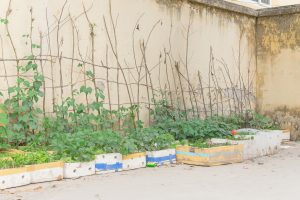In the heart of Vietnam, where ancient traditions intertwine with modern aspirations, a curious symbol has emerged as a stark representation of the country’s deep-rooted corruption: the Styrofoam box. These humble containers, once used to transport everyday items such as fresh produce and packaged goods, have become synonymous with the brazen acts of bribery and illicit wealth accumulation that plague Vietnamese society.
Paradoxically, the association of the Styrofoam box with corruption has its roots in the common practice of reusing such boxes to plant “clean” vegetables, a practice born out of a desire to avoid the use of pesticides and other chemicals commonly found in market-bought produce. This practice reflects the deep-seated concerns of many Vietnamese about the safety of their food supply and the lengths they are willing to go to protect their families’ health.
However, the Styrofoam box’s image has been tarnished in recent times, when it was used as a literal vessel for a series of high-profile corruption scandals. In one particularly infamous case, the full scale of which was revealed this month, Truong My Lan, a businesswoman associated with the real estate conglomerate Van Thinh Phat, was indicted on three charges: bribery, violation of banking regulations, and embezzlement. Lan confessed to bribing Do Thi Nhan, the former head of Inspection and Supervision Department II under the State Bank of Vietnam, with $5 million in cash, neatly stashed in three Styrofoam boxes.
In another instance, Phan Van Anh Vu, also known as Vu “nhom,” the former Chairman of the Bac Nam 79 Construction JSC, admitted to using three Styrofoam boxes to transfer $4 million in cash to Nguyen Duy Linh, the former deputy director of the Ministry of Public Security’s General Department of Intelligence.
These cases, just the tip of a vast iceberg of corruption, have exposed the insidious nature of bribery in Vietnam, where Styrofoam boxes have become the preferred vessels for transporting ill-gotten wealth.
The Styrofoam box’s metamorphosis from an emblem of wholesome living to a symbol of corruption has left a lingering bitterness in the hearts of many Vietnamese people. The sight of these boxes, once associated with the nurturing of life, now elicits a profound sense of disgust and despair, serving as a stark reminder of the vast sums of money that have been siphoned away from the public and into the coffers of the corrupt.
Indeed, according to the results of the investigation of the Ministry of Public Security that was made public on November 17, Lan has been accused of embezzling the astonishing sum of $12.36 billion from Saigon Commercial Bank, where she has long held a majority stake.
Yet, amidst the pervasive corruption, there remains a glimmer of hope. The increasing public awareness and outrage over these cases have spurred calls for stricter enforcement of anti-corruption laws and greater transparency in government dealings. The Styrofoam box, once a symbol of concealment, may yet become a catalyst for change, driving Vietnam towards a future where honesty and integrity prevail over the allure of ill-gotten gains.
However, the path to reform will be challenging. The entrenched power of corrupt networks and the complicity of powerful officials pose significant obstacles to meaningful change. Nevertheless, the stories of those who have dared to speak out against corruption, as well as the anger and pressure from the public, serve as beacons of hope, illuminating the possibility of a brighter future for Vietnam, even though these brave individuals may face suppression in the meantime.
In this struggle against corruption, the Styrofoam box may yet serve a dual purpose. While it currently represents the depths of corruption, it can also become a symbol of resilience and the unwavering pursuit of justice. Once used to conceal ill-gotten gains, it could be transformed into a vessel for transparency and accountability, a symbol of Vietnam’s determination to shed the shackles of corruption and build a more just and equitable society.

































